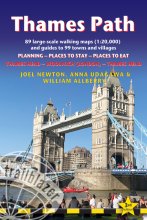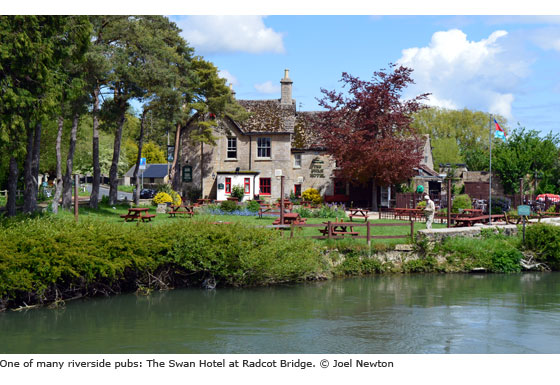Trailblazer guidebooks provide practical information on specific routes in less accessible parts of the world.
— Wanderlust

Thames Path: Thames Head to Woolwich (London)
Excerpt:
Planning your walk
Contents | Introduction | About the Thames Path | Planning your walk | Using this guide | Sample route guide
Route finding
Your chances of getting lost on the Thames Path are remote. Following the river for most of its duration, even the author – often lost in his thoughts – didn’t stray from the trail throughout.
Along the length of the path, gates and wooden signposts are marked with the acorn symbols which are used to denote the National Trails of England and Wales.
On the odd occasion the path strays from the river these will ensure you stay on the path. In London, on the rare occasion that the route may be slightly confusing the relevant section of this book will hopefully help you keep to the trail.
Budgeting
The UK is not a cheap place to go travelling in and the accommodation providers on the Thames Path are more than accustomed to seeing tourists and charge accordingly.
You may think before you set out that you are going to keep your budget to a minimum by camping every night and cooking your own food but it’s a rare walker who sticks strictly to this rule.
Besides, the pubs on the route are amongst the path’s major attractions and it would be a pity not to sample the hospitality in at least some of them.
If the only expenses of this walk were accommodation and food, budgeting for the trip would be a piece of cake.
Unfortunately, in addition there are all the little extras that push up the cost of your trip: getting to and from the path, beer, snacks, stamps and postcards, museums, buses and trains here and there, laundry, souvenirs ... it’s surprising how much all of these things add up.

Camping
You can survive on less than £20 per person (pp) if you use the cheapest campsites, never visit a pub, avoid all museums and tourist attractions in the towns, cook all of your own food from staple ingredients and generally have a pretty miserable time of it.
Even then, unforeseen circumstances will probably nudge your daily budget above this figure.
Include the occasional pint and perhaps a pub meal every now and then and the figure will be nearer to £25-30pp a day. And remember that once in London you’ll need to allow for the extra cost of a hostel (see below) on at least two nights as there are no campsites.
Hostels
A dorm bed costs between £15pp (in winter) and £32pp (peak times in London) per night, although a bed usually costs £17-25pp.
Some of the hostels offer accommodation in single or 2-bed rooms, a few of which are en suite; but they do cost a little more, with 2-bed rooms typically costing £35-70 per night depending on the location and time of year.
Non-members of the YHA pay £3 per night more. Rates do not include breakfast so an allowance for this as well as for other meals, unless you are self-catering, and also for the extras mentioned above, will need to be included in your budget.
B&Bs, guesthouses and hotels
On average, a night in a B&B will cost £30-50pp based on two people sharing a room (£40-80 for a single or single occupancy) per night.
Adding the cost of food and drink for both lunch and dinner as well as an allowance for the standard expenses mentioned above, you should reckon on an average of about £65-70pp per day, although other unexpected costs will likely mean you may need to budget slightly more. See also p21.
Itineraries
To help you plan your walk there is a planning map (opposite the inside back cover) and a Village and Town Facilities table (pp32-7), which provide a summary of the services en route.
At the back of the book the colour maps show the walk divided into stages as in the route guide.
See p16 for a list of day and weekend walks which may be better if you don’t have time to do the whole walk in one go.
Which direction?
Whilst this book follows the Thames Path from west to east – ie downstream from source to sea – there is really no reason why you can’t walk in the opposite direction.
You would, of course, lose the dramatic effect of witnessing the river’s growth and you’ll also be walking against the flow of the river; it’s often said, too, that by walking east you’ll have the weather (the prevailing wind and the sun) on your back for most of the time.
But many folk – those three men in that boat for example (see p47) – have tackled the river by leaving London and following the waters westward, in search of the source.
Suggested itineraries
The itineraries on pp30-1 are based on different accommodation types (camping/ hostel and B&B/hotel), each divided into three options depending on your walking speed.
They are only suggestions so feel free to adapt them. Don’t forget to add on your travelling time before and after the walk. If using public transport a map and service details are on pp54-7.
Once you have an idea of your approach turn to Part 4 for detailed information on accommodation, places to eat and other services in each village and town on the route. Also in Part 4 you will find summaries of the route to accompany the detailed trail maps.
Festivals and events
Before leaving home it is wise to be aware of any cultural or sporting events which could turn your peaceful riparian stroll into something much more boisterous.
You may wish to consider either avoiding or participating in the following events whilst planning your walk.
Note that as well as those mentioned many other major sporting events – such as rugby matches at Twickenham – and cultural events occur in or near to places on the Thames Path and these may push up the price of accommodation and also mean it gets fully booked.
A useful website for information about festivals and major events in and around London is www.visitlondon.com.
Thames Path: Thames Head to Woolwich (London)
Excerpts:
- Contents
- Introduction
- About the Thames Path
- Planning your walk
- Using this guide
- Sample route guide
Price: £12.99 buy online now…
Latest tweets